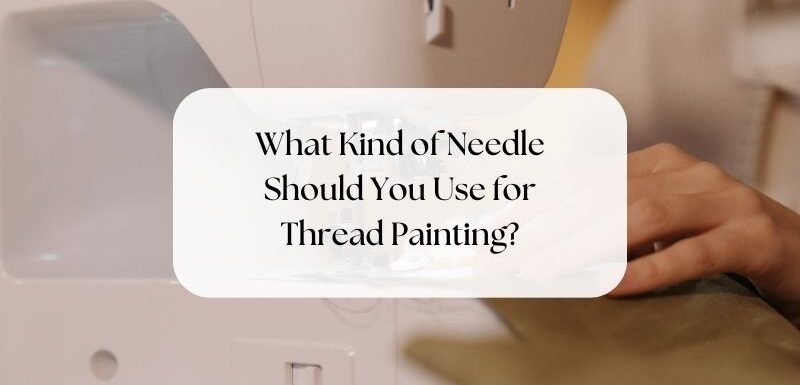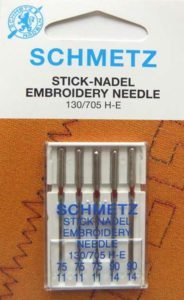Ask 100 people for their response about what kind of needle you should use for thread painting, and you’ll likely get 100 different answers.
Well, perhaps I’m exaggerating – it may only be 90 different answers!
Everyone has their favourites and, after a bit of experimentation, knows what works for them.
Before you even go near the question of what ‘size’ or ‘type’, perhaps you should be looking at what you’re making … and beyond.
My (personal) choice defaults to machine Embroidery needles for the majority of my work. But please keep in mind that that is MY choice.
Embroidery needles are appropriate for most of the work that I do.
But this type may not be appropriate for you.
Table of Contents
- A. Factors that affect your choice of needle type:
- B. What TYPE of needle should you use for thread painting?
- C. Which BRAND of needle should you use for thread painting?
- D. What SIZE needle should you use for thread painting?
- My final word on needles for thread painting:
Affiliate Disclosure: Some of the links on this site are affiliate links. This means I may receive a small commission (at no further expense to you) if you click through and make a purchase. ThreadSketchingInAction.com is a participant in the Amazon Services LLC Associates Program, an affiliate advertising program designed to provide a means for sites to earn commission fees by advertising and linking to Amazon.com.
A. Factors that affect your choice of needle type:
- What are you making? Single-layer thread embellishment or detailed art quilt enhancement?
- How many layers are involved? One, two, three, more…?
- What fabric types are you using? Cotton, silk? Piled fabrics such as velvet or faux fur? Are you working on knit fabrics, leather or vinyl? What about sheer fabrics?
- Is there stabiliser and, if so, does it have synthetic or natural composition? Is it fused or not fused?
- What is the purpose of your work? E.g. is it a simple thread sketch or an intricate thread painting?
- What thread are you using? Cotton, rayon, polyester, metallic?
MY RECOMMENDATION: (based on my personal experience and type of work) – Machine Embroidery needles.
B. What TYPE of needle should you use for thread painting?
Go back and answer the same questions (1 – 6) as in the previous topic (A)!
Examine exactly what it is you are making:
- Are you doing fine embroidery work?
- Quilting or topstitching?
- Working on knit or stretch fabrics?
- Working on heavy fabrics such as denim or even leather?
- Does your fabric have a pile or nap? e.g. velvet, faux fur, corduroy?
Then you need to choose from needles that suit these different situations:
- Embroidery needles.
- Quilting needles
- Top-stitch needles.
- Ball-point or jersey needles.
- Denim or jeans needles.
- Needles for metallic threads.
- Universal needles (all-purpose).
- Microtex needles, for use with fine fabrics, microfibre and some synthetics.
- Twin needles
MY RECOMMENDATION: Machine embroidery needles are designed explicitly for machine embroidery, so (IMO) should be your first port of call.
C. Which BRAND of needle should you use for thread painting?
Some needle brands suit specific machines better than others.
For example, my Brother machine LOVES Schmetz needles and dislikes most other brands. So, naturally, I stick with Schmetz needles.
Your machine may have other tastes!
MY RECOMMENDATION: Ask the supplier of your machine for advice, or experiment until you find a needle brand that your machine works with ‘nicely’.
D. What SIZE needle should you use for thread painting?
At risk of sounding repetitive, go back and answer the same questions (1 – 6) as in Topic A.
Regarding size, most projects can be effectively worked using a needle in the size range 75/11 – 90/14, depending on fabric type and the number of layers you’re stitching through.
Most of the time, I will use a 75/11 or 80/12 size needle. But remember – that is for the type of work that I do. Yours may differ.
MY RECOMMENDATION: For the majority of thread painting projects, a needle in the size range 75/11 – 90/14 should be appropriate. Be sure to test it on a sample first.
My final word on needles for thread painting:
Regardless of which brand, size or type of needle you decide on for your work, I implore you to use good quality needles.
If you have to compromise anywhere on quality and cost, do not skimp on needle quality.
Working with inferior needles leads to problems with tension, stitching and, generally poor results.
Find what works for you and stick to it (most of the time)!


